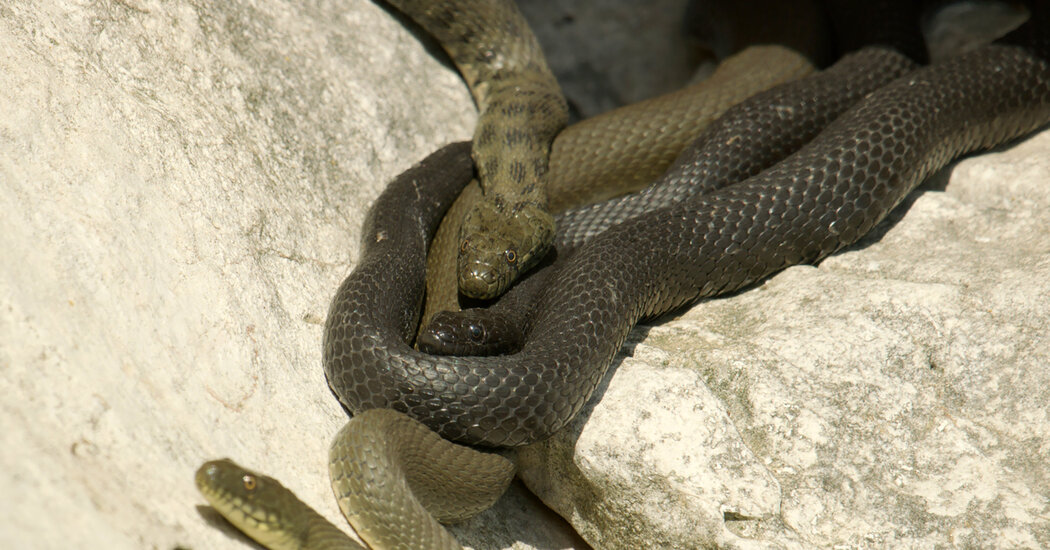Most snakes flee or fight when attacked. Then there are the dice snakes of Golem Grad, an island on a lake in North Macedonia. Grabbed by a predator, they writhe theatrically, soiling themselves with a pungent cocktail of musk and feces. Eventually they go limp, mouth gaping, tongue protruding. To really sell the part of playing dead, some even bleed from their mouths.
Just as buckets of stage blood can help sell an unconvincing fight onstage or onscreen, the snakes’ use of disgusting fluids may be the key to putting on a convincing death performance, according to research published Wednesday in the journal Biology Letters.
Various species across the animal kingdom feign death when bothered by a predator, including insects, fish and amphibians. Even mammals do it — the most famous of which has lent its name to the technique: “playing possum.”
Such a performance can be a “high risk, high reward scenario,” said Vukasin Bjelica, a doctoral student at the University of Belgrade and an author on the study. Some predators are confused — or disgusted — by animals that abruptly go limp, especially while those animals are stinking and bleeding. Others may stop paying close attention and loosen their hold, giving prey time to escape. But it requires the performer to lie unmoving around an animal that is interested in eating it. The prey therefore has a strong incentive to try to lessen the amount of time spent playing dead.
Mr. Bjelica’s research is focused on dice snakes, a nonvenomous, fish-loving species found from Western Europe all the way to western China. The species as a whole has a variety of defensive techniques, including biting, puffing up and flattening their heads to look like a venomous snake. But the snakes of Golem Grad island — whose main predators are birds — often play dead.
The research team led by Mr. Bjelica captured and tested 263 snakes, lunging after them and grabbing them around the middle to provoke the widest range of defensive behaviors. While careful not to hurt the snakes, they held them, gently squeezed them and stretched them out on the ground. “We acted like a predator that’s hesitant to eat the prey and then recorded to see what they’d do,” Mr. Bjelica said.
They noted when the snakes smeared themselves in feces and musk (just under half the snakes), when they allowed blood to bubble from their mouths (only 10 percent), and how long the snakes played dead. Some snakes were quite tense while playing dead, making them difficult to move. Others went so limp that younger students arranged them in heart shapes.
“They really commit to the role, depending on the individual,” Mr. Bjelica said. The strategy seemed to work best for adult snakes, Bjelica said, which are somewhat less vulnerable to predators. Juvenile dice snakes — which are often snatched by birds — were significantly less likely to take the risk, and played dead for far less time. And as the team had guessed, snakes that bled from the mouth and doused themselves in musk and feces tended to play dead for two seconds less than others on average.
In predator-prey interactions, each second counts, Mr. Bjelica said. “Two seconds might not be much when you’re reading the paper, but it could be enough for a snake to make a successful escape,” he said. The strategy also seems to work best when there are a lot of other prey animals around, allowing predators to be distracted and taking their attention off the snake that is playing dead.
Mr. Bjelica sounded a note of caution on the research, however. Because most of the data comes from one rather unusual population — island snakes entirely hunted by birds and graduate students — more research, ideally including real-world observation, is necessary in other populations and among other snake species make the same calculations.
And some variables will be impossible to test, Mr. Bjelica conceded.
“We’re not trying to hurt the snake, so you’re not going to grasp and handle them like a predator would do,” he said. “But the predator is not thinking in terms of ethical restrictions or methodology sections in a research paper.”
